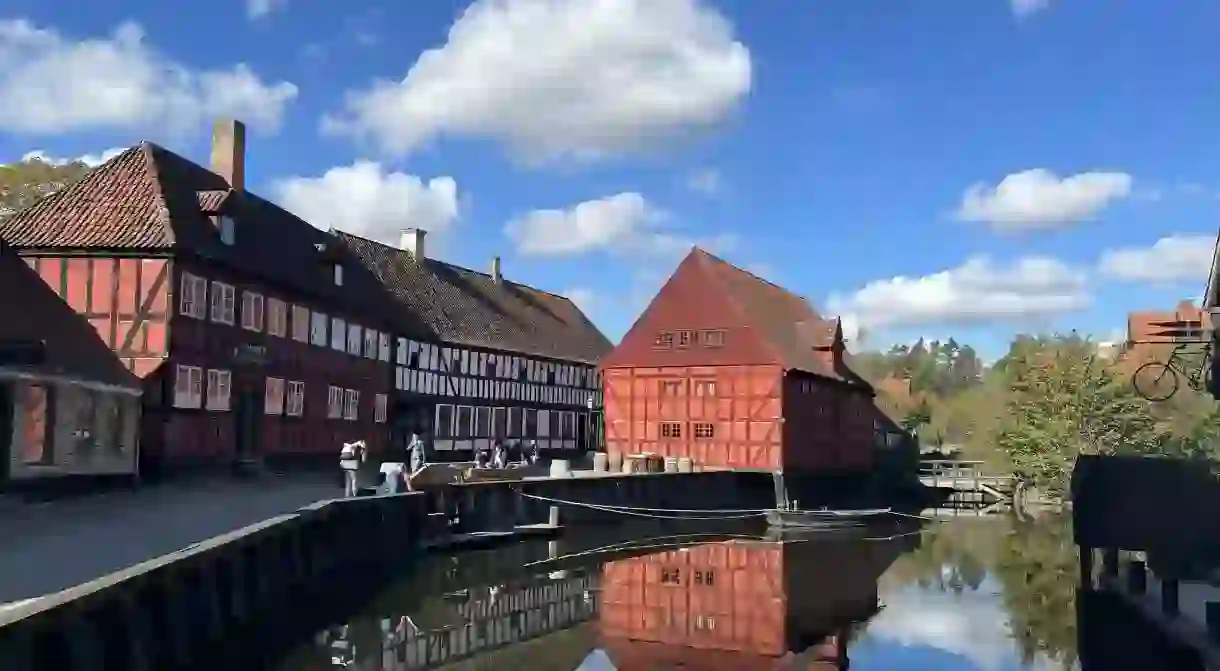Exploring Aarhus, Denmark's Second City

The monumental spiral staircase at the centre of ARoS – Aarhus’ Contemporary Art Museum – soars upwards despite its heft. Any visitor to the city should start here, and we’ve picked out more essential stops for your trip to Denmark’s second-largest city.

In each of the art museum’s lofty white galleries there is masses of airy space to appreciate the innovative art: most recently (until January 2025) Ron Mueck’s enormous sculptures of a newborn and a squatting boy – alongside the diminutive mother-figure, burdened by her plastic shopping bags. The unhurriedness of it all – ARoS’ modern but laid-back vibe – is oddly energising. There’s freedom here to think one’s own thoughts, to stand and stare. The invitation is to embrace the city’s relaxed vibe.
Upstairs, on the roof, is Olafur Eliasson’s rainbow panorama – a 360-degree walkway hovering above the city, its glass panes modulating from red to orange and yellow before turning through cool green, blue and indigo. Over there to the right are the old docks with their functioning warehouses and cargo boats tethered under spiderly cranes: rocking on the same swell that brought the Vikings to the Jutland peninsular.

Aros is the perfect way to get under the skin of Aarhus before setting out to explore. What you see from on high is that its scale is walkable and like so many other second cities – Lyon, Munich Bruges and so on – it is a potent mix of old and new. It’s full of history – from the Vikings to its timbered medieval houses and the superb cathedral with its 15 th century frescoes. Yet the city is also characterised by striking modernity – from ARoS through to Arne Jacobsen’s 1940s brutalist Town Hall and the madly modern district – ø – that stretches out from the centre towards the forests in the east.
Epitome of this old-meets-new is The Royal Hotel, the grand dame of Aarhus. The ancient glass and wrought iron lift that rises through its centre is a gem but there’s also a diminutive sauna and an animated breakfast / dining room for ginger shots, cottage cheese, smoked fish and ham – or croissants and coffee – all under a great glass pyramid. The penthouse – affordable for three families to share – gives another of those roof-top views that you soon realise the Danes simply adore.

The Royal has the best location too. Sitting in the shadow of the striking cathedral is is but a four- minute walk to the pedestrian shopping street – Strøget – (check out another must-go roof garden on the top floor of the Salling department store). In the opposite direction are the higgledy-piggledy houses and streets of the cobbled Latin quarter, colonised by students on bell-pinging bikes and peppered with houses with burnt-sienna plaster. Here are small luxy boutiques (check out Audo for enviable homewares) and boho clothes shops, all rubbing shoulders with the swanky tech of Bose.
There’s so much to suck up in Aarhus. Den Gamle By is a living museum: its streets, houses and shops recreating various ages of the city since the nineteenth century. However sceptical you might be, this is no Legoland, plastic experience. Here are piles of dung from horses kept in timbered courtyards. There’s an early-twentieth- century baker selling authentic pastries, a 1950s hairdresser and a 60s camera store. Three hours is hardly enough to take it all in. I never thought I’d write it, but it’s one of the best ‘touristy’ attractions around, genuinely re-creating the relatively recent history of the city’s people.

Right in the centre of Aarhus, there’s a much smaller – and subterranean – Viking Museum. The world-class Moesgard Museum of archaeology and ethnograpy and Marselisborg Castle and gardens are both a short bus ride outside the city. There are hours of cobbled walks hardly disturbed by cars, a flourishing Botanic Garden with striking glasshouses and a butterfly garden structure you can climb up. There’s even a theme park – Tivoli Friheden – with rollercoasters.
Aarhus ø is the uber modern district to the north – an easy twenty-minute walk from the centre – containing Denmark’s second tallest residential tower, the Lighthouse. Here the lift travels at 8m a second to another vertiginously birds-eye viewing platform looking westwards over the bay in the direction of Sweden. And with the backdrop of all this residential avant-gardism is a watersport park offering cable-ski and wakeboarding.
A little way further out are simple beaches (rent a bike). Or, head for the triangular floating complex known as the Harbour Baths – with its swimming, diving and children’s pools as well as a couple of saunas, bars and restaurants (there’s even a small theatre). For my film-camera-crazy son endlessly propelled by the photographer’s eye, there’s also the wooden infinite bridge (another 360-degree installation) and the endlessly- insta’d Møllestien Lane with its colourful cottages. There’s the energy of canal-side Aboulevarden with its cafes and nightlife and – everywhere it seems – world-beating contemporary architecture alongside traditional Danish design.

Come here to look and to wander. Suck up culture and history or scoff down kanelsnurre (addictively delicious cardamom or cinnamon pastries: check out La Cabra in Borggade). Tuck into dinner at a small swanky restaurant by the canal or cathedral, or check out the tiny pizza café Piccolina (book in advance or take a pizza out and eat it on the cathedral steps). Don’t miss he sensory-overload that is Tørv streetfood: a buzzy stall for every national cuisine you can think of, all under the roof of one of the city’s old bus garages.
Seagulls spin over this seaside city. In the shoulder seasons of spring and autumn a slanting light comes off the water. It’s all characterised by easy-going Nordic deliberation and a warm familiarity impossible to find in Denmark’s busier, grander, and more self-important capital. All in all, Aarhus is a bit of a revelation.













